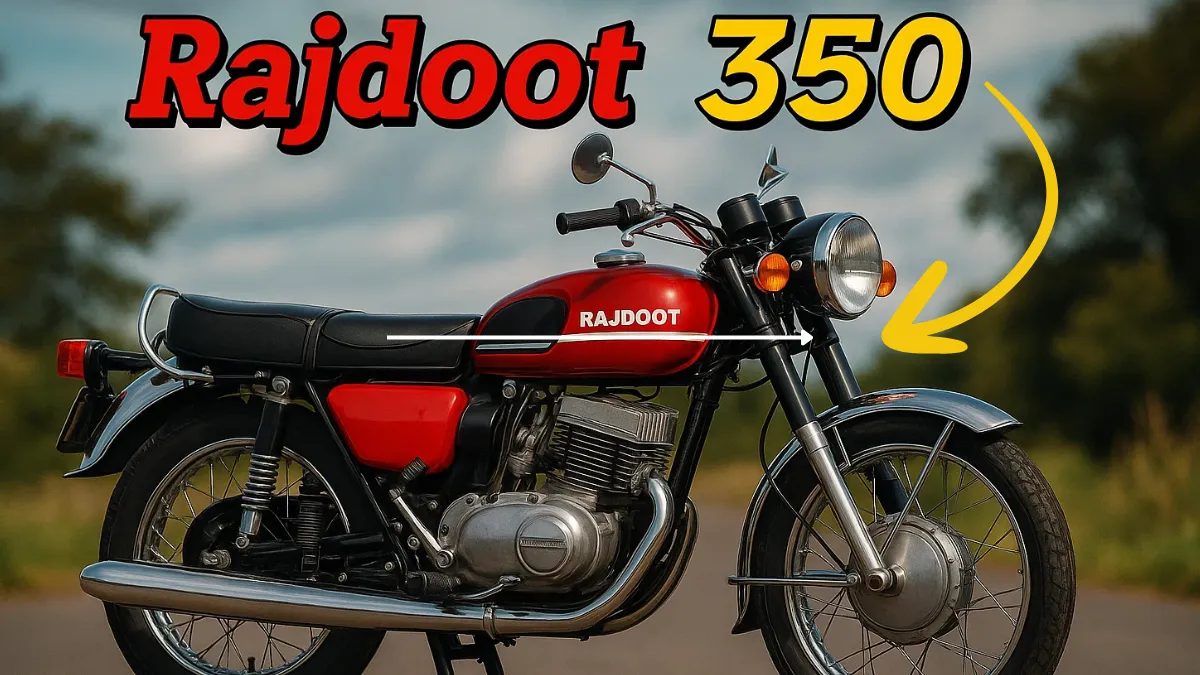Few motorcycles in India have achieved the cult status of the Rajdoot 350. At a time when the Indian motorcycle market was dominated by small-capacity, commuter-oriented bikes, the Rajdoot 350 stormed in with a bold two-stroke engine, unmatched performance, and global pedigree.
Manufactured under a collaboration between Escorts Group and Yamaha, the Rajdoot 350 was essentially the Indian version of the Yamaha RD350, a motorcycle that had already made waves internationally. Launched in the mid-1980s, it quickly became a symbol of power, thrill, and aspiration for a generation of Indian riders.
This article explores the design, performance, history, cultural impact, challenges, and lasting legacy of the Rajdoot 350, showcasing why it continues to be remembered fondly even decades after it disappeared from showrooms.
The Origins of the Rajdoot 350
The story of the Rajdoot 350 begins with Yamaha’s legendary RD350, a two-stroke motorcycle that gained fame worldwide for its blistering speed and raw performance. Escorts, which was already selling Rajdoot-branded commuter motorcycles in India, collaborated with Yamaha to bring this machine to Indian soil.
Launched in 1983 as the Rajdoot Yamaha RD350, the bike was locally manufactured in Faridabad, Haryana. While the global version was known as the “Rocket” for its insane acceleration, the Indian version was detuned to suit fuel efficiency concerns and local riding conditions.
Even so, the Rajdoot 350 was miles ahead of anything available in India at that time. For context, most commuter bikes back then produced around 6–8 horsepower, while the Rajdoot 350 produced more than three times that output.
Design and Styling
The Rajdoot 350 carried the classic styling of the 1970s and 80s, which gave it a timeless charm.
- The round headlamp and twin-pod instrument cluster gave it a retro yet purposeful look.
- Its teardrop-shaped fuel tank with simple graphics reflected Yamaha’s global design language.
- The flat, wide seat provided comfort for both rider and pillion.
- The twin exhaust pipes not only enhanced its sporty character but also produced the iconic two-stroke sound that enthusiasts still remember.
The overall design was understated compared to its performance, but it became iconic precisely because of its clean, no-nonsense look paired with raw power. Even today, restored Rajdoot 350s turn heads at bike meets thanks to their vintage styling and unmistakable sound.
The Two-Stroke Beast
The heart of the Rajdoot 350 was its 347cc, air-cooled, two-stroke, parallel-twin engine.
- The high-torque (HT) version produced around 27 horsepower, while the low-torque (LT) version made 28–31 horsepower.
- Despite being detuned compared to the international Yamaha RD350 (which produced up to 39 horsepower), it was still far more powerful than any Indian bike of the era.
- The bike was capable of hitting a top speed of over 140 km/h, an unbelievable figure at the time.
The powerband of the two-stroke engine delivered an adrenaline rush like no other. Riders who twisted the throttle were rewarded with instant acceleration and a spine-tingling exhaust note, making the Rajdoot 350 feel like a true superbike for its generation.
Riding Dynamics
The Rajdoot 350 was not just about straight-line speed; it was also engineered for a thrilling riding experience.
- Its lightweight chassis and well-tuned suspension gave it excellent handling.
- The front disc brake in later models provided strong stopping power, a rarity in India at that time.
- The low-slung stance and wide handlebars ensured good control, whether cruising on highways or tackling twisty roads.
However, the bike demanded respect. Its powerful two-stroke motor could easily overwhelm inexperienced riders, earning it the nickname “Widow Maker” among enthusiasts.
Challenges in the Indian Market
Despite its unmatched performance, the Rajdoot 350 struggled in India for several reasons:
- High Price – At launch, it was significantly more expensive than commuter bikes like the Hero Honda CD100 or the Bajaj Chetak scooter.
- Poor Fuel Efficiency – The two-stroke engine consumed a lot of fuel, averaging just 20–25 km/l, which was impractical in a market obsessed with mileage.
- Maintenance Costs – Spare parts were expensive, and few mechanics had the expertise to handle its complex engine.
- Ahead of Its Time – Most Indian buyers in the 1980s were not ready for a high-performance motorcycle, preferring economical and reliable options instead.
These factors limited its commercial success, but ironically, they enhanced its legendary status in later years.
Cultural Impact
The Rajdoot 350 may not have sold in huge numbers, but it left a deep cultural mark on India’s motorcycling scene.
- It became the dream bike for young riders, symbolizing freedom, rebellion, and status.
- Bollywood movies of the era often featured the bike in high-speed chase scenes.
- Motorcycle clubs across India still celebrate the Rajdoot 350, organizing rides and restoration projects.
- Its distinctive two-stroke exhaust note is still considered music to the ears of biking enthusiasts.
For many, the Rajdoot 350 was the first taste of true motorcycling performance in India.
Legacy of the Rajdoot 350
Though it was discontinued in the late 1980s due to poor sales, the Rajdoot 350 laid the foundation for performance biking in India. It proved that Indian riders, too, could aspire for motorcycles beyond basic commuting.
Its legacy can be seen today in:
- The popularity of performance bikes from KTM, Bajaj, Yamaha, and Royal Enfield.
- The growth of motorcycle culture in India, including racing, touring, and superbike clubs.
- The thriving restoration market, where original Rajdoot 350s are restored and sold at premium prices.
Enthusiasts consider it a collector’s item, and owning a well-maintained Rajdoot 350 today is a badge of honor.
Rajdoot 350 vs Yamaha RD350
A major part of the Rajdoot’s story lies in its comparison with the global Yamaha RD350.
- The international RD350 produced close to 39 horsepower, significantly higher than the Indian version.
- The Rajdoot 350 was detuned with different carburetors and ignition settings to improve mileage and suit local fuel quality.
- While the global RD was a hardcore performance bike, the Indian Rajdoot 350 was more of a compromise between performance and practicality.
Still, for Indian riders in the 1980s, the Rajdoot 350 felt like owning a superbike.
The Two-Stroke Nostalgia
Ask any motorcycle enthusiast about the Rajdoot 350, and they will instantly talk about its sound and smell.
- The raspy, throaty exhaust note of its parallel-twin two-stroke engine is unforgettable.
- The faint blue smoke that accompanied every ride added to its raw character.
- It gave riders an emotional connection—something modern, refined four-strokes rarely deliver.
This nostalgia is one of the biggest reasons why the Rajdoot 350 remains so loved today.
Collector’s Pride and Restorations
Today, finding a Rajdoot 350 in good condition is rare, but motorcycle collectors and restorers are keeping the legend alive.
- Restored often sell at premium prices, sometimes crossing modern 250–300cc bike costs.
- Enthusiasts invest heavily in sourcing original spare parts to keep the bike authentic.
- Dedicated clubs and online forums bring together Rajdoot 350 owners to share knowledge, stories, and rides.
Owning one today is less about practicality and more about preserving a piece of India’s motorcycling heritage.
Why Enthusiasts Still Love It
Even decades after its discontinuation, the Rajdoot 350 enjoys a cult following because:
- It was India’s first real performance motorcycle.
- The two-stroke thrill is unmatched by modern four-stroke engines.
- Its simplicity and rawness give it a pure motorcycling feel.
- It represents a bygone era of biking, where machines demanded skill and courage.
Conclusion
The Rajdoot 350 may not have been a commercial success, but its impact on India’s motorcycling history is undeniable. It introduced Indian riders to a new world of performance, style, and thrill.
For the generation that grew up in the 1980s and 90s, it remains a nostalgic symbol of youth and aspiration. For today’s enthusiasts, it represents a timeless classic that defined what it meant to ride with passion.
In many ways, the Rajdoot 350 was not just a motorcycle—it was a revolution on two wheels, a machine that changed the way India thought about biking forever.

